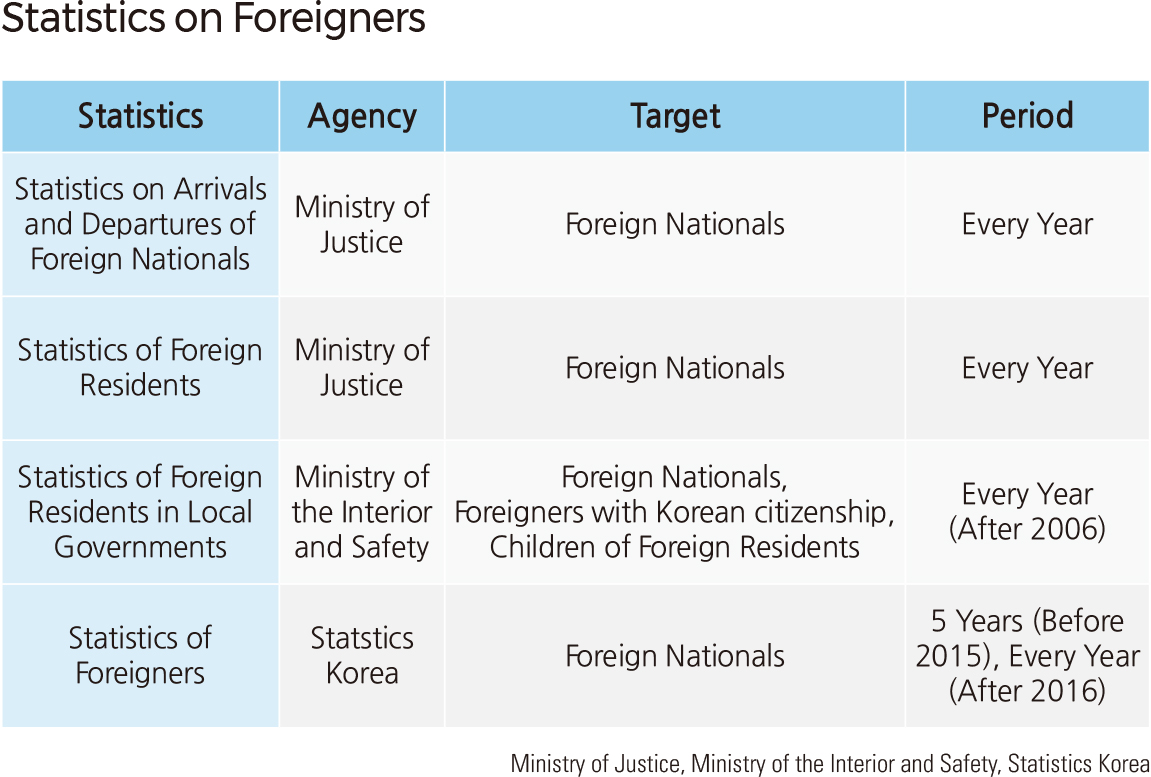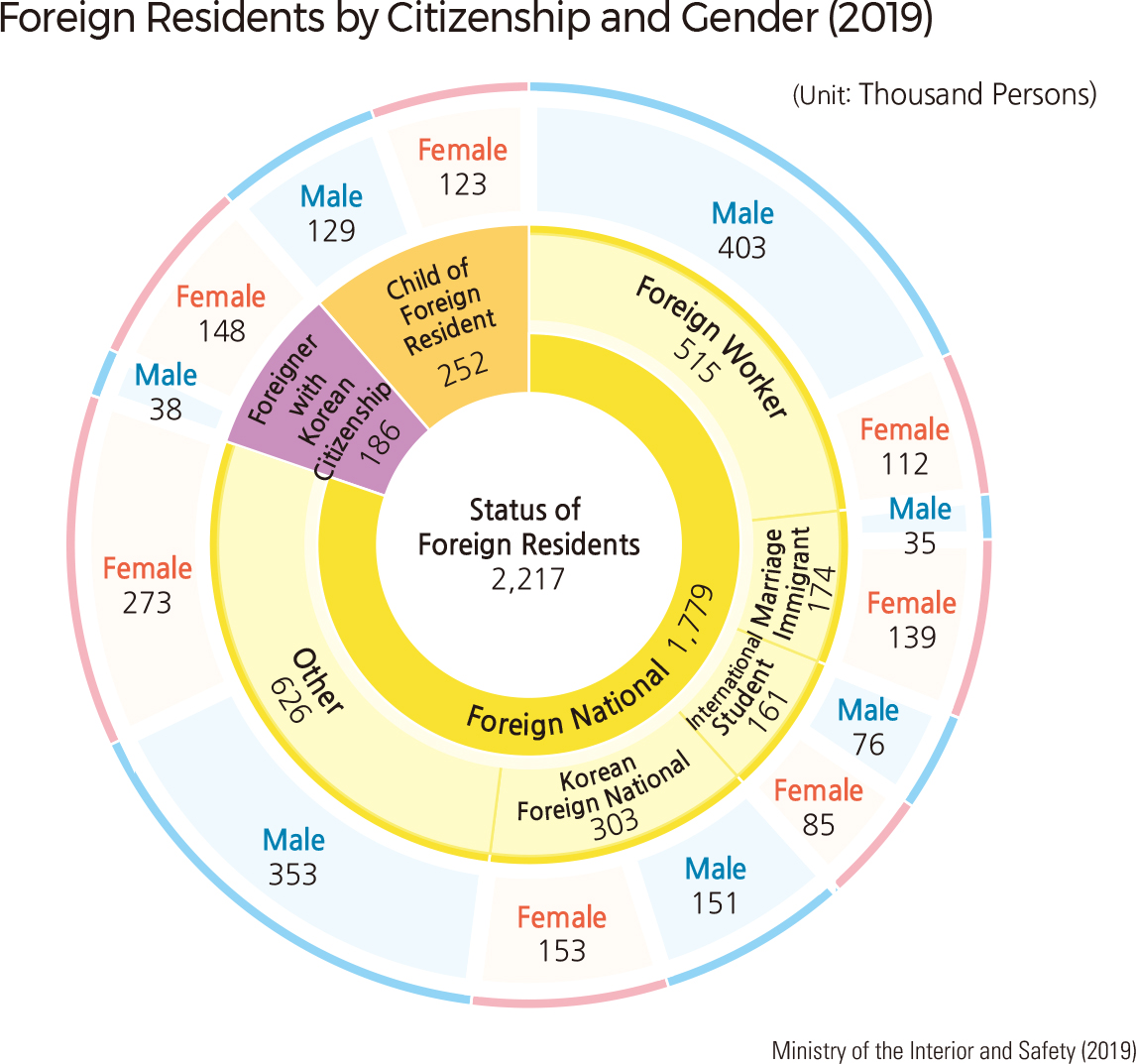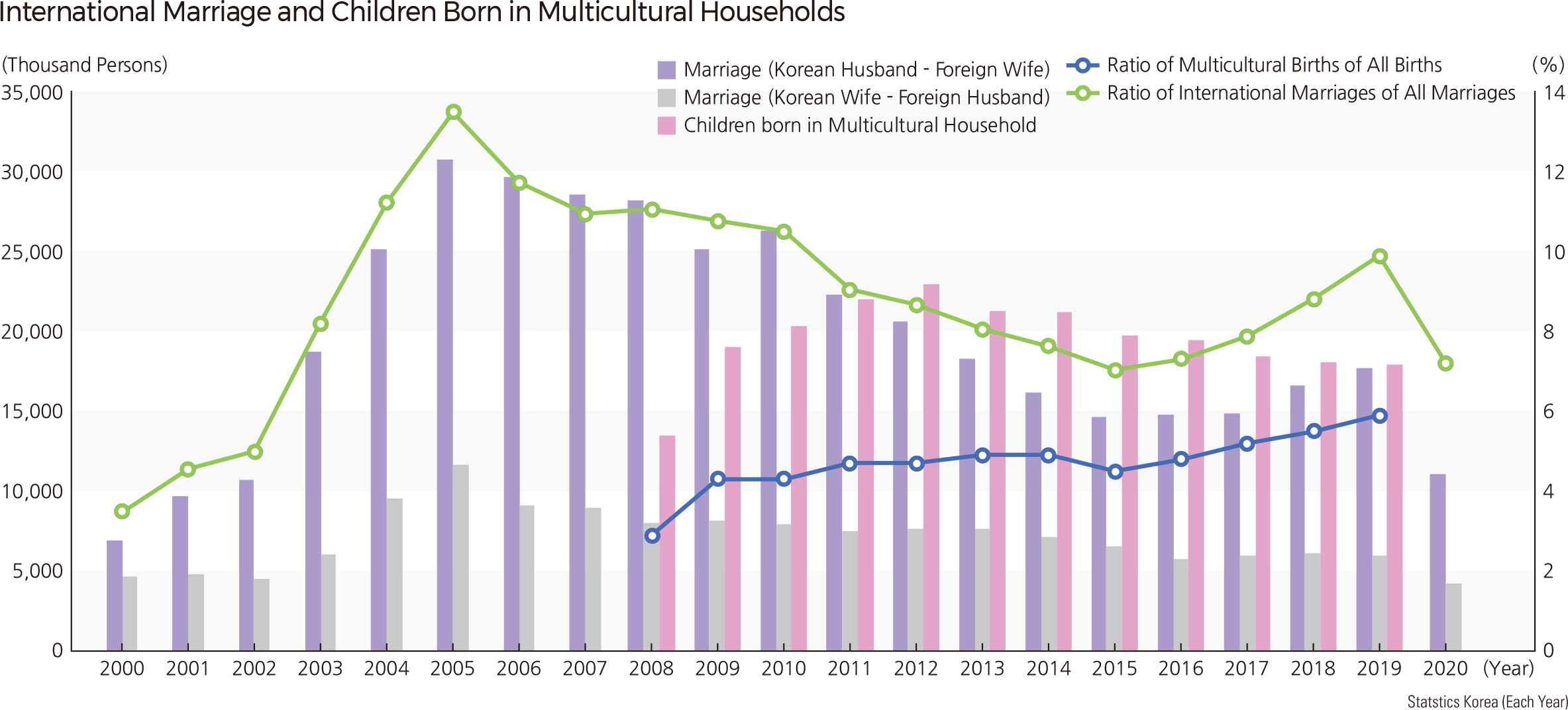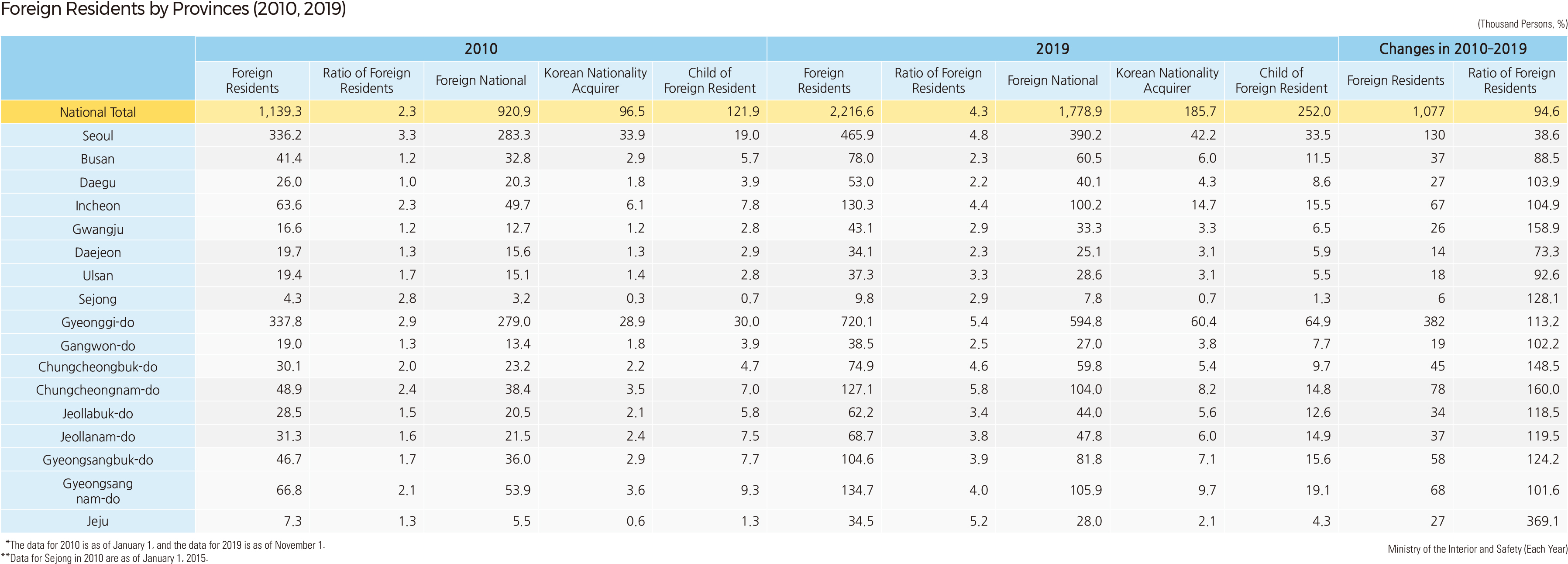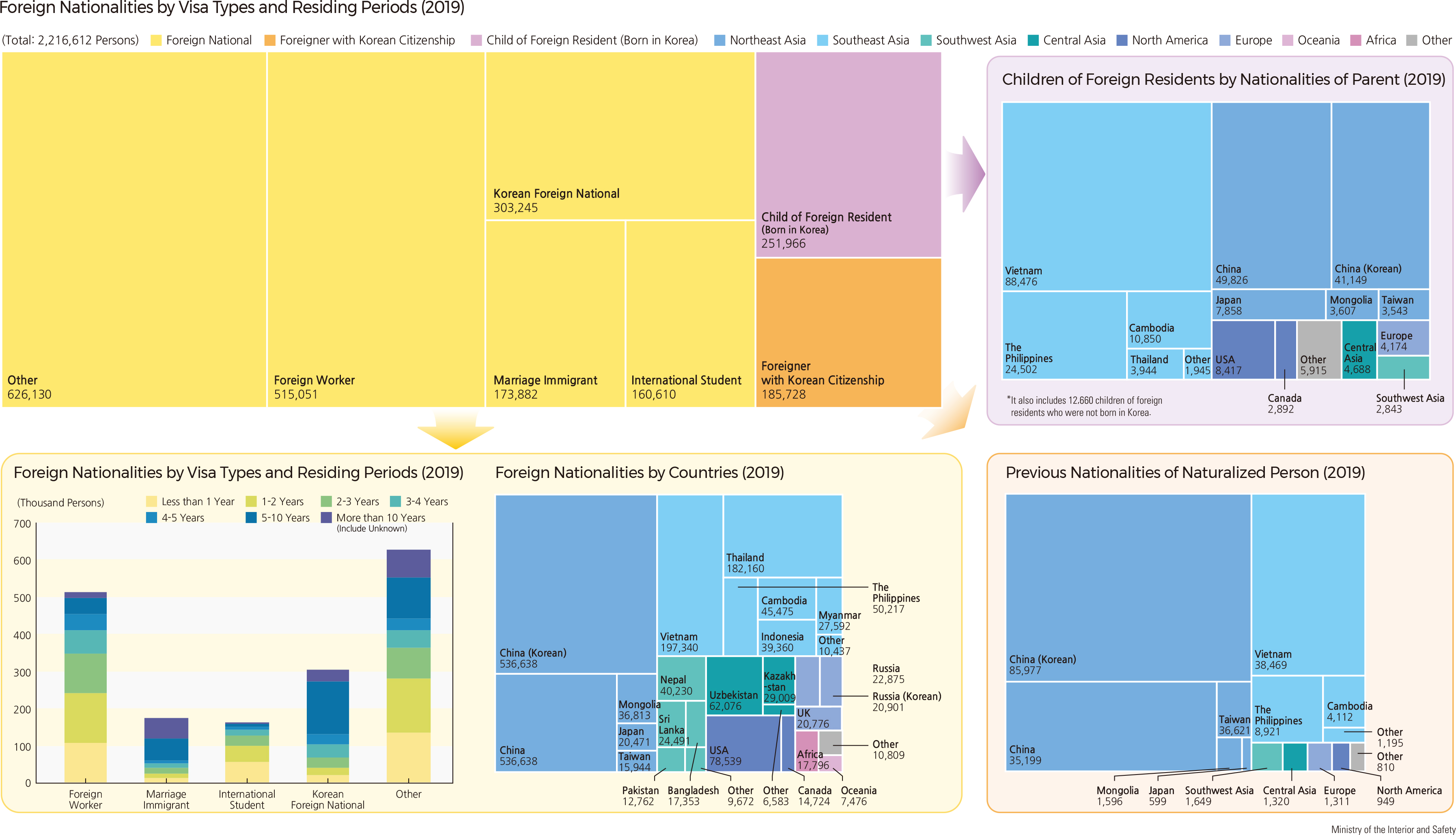English III 2021
The Ministry of Justice, the Ministry of the Interior and Safety, and Statistics Korea collect statistics on foreigners. The Ministry of Justice compiles the “Statistics of Foreign Residents” to manage the immigration of foreigners. The Ministry of the Interior and Safety obtains the “Statistics of Foreign Residents in Local Governments” to develop policies that support foreign migrants settling in local communities. Statistics Korea compiles the “Statistics of Foreigners Residing or Staying in Korea” as a part of the census to understand the current status of foreigners. However, the results of the respective statistics are not necessarily consistent since the categories of foreigners included in these statistics do not perfectly align with the other agencies. Statistics on the arrival and departures of foreign nationals include short-term residents for tourism and other purposes. Due to the impact of COVID-19, the number of arrivals and departures of foreign nationals in 2020 sharply decreased. The number of foreigners included in the Statistics of Foreign Residents by the Ministry of Justice is the largest since it includes illegal immigrants as well. The number of foreign residents included in the Statistics of Foreign Resident in Local Governments is the second largest since it includes foreign nationals, foreigners with Korean citizenship, and the children of foreign residents. Finally, the number in the Statistics of Foreigners, which only includes foreign nationals, is the smallest. According to the Ministry of the Interior and Safety’s Statistics of Foreign Residents in Local Governments, there were 540 thousand foreign residents in 2006, accounting for 1.1% of the total population. However, the number increased to 2.22 million in 2019, accounting for 4.3% of the total population. In 2019, foreigners with a foreign nationality made up 80.2% (1.78 million) of the foreign residents. They are foreign workers, foreign nationals, marriage immigrants, and international students. Marriage immigrants are foreigners residing in Korea who have been married to Korean citizens or are in a marital relationship with a Korean citizen. Most foreign workers are men, while most marriage immigrants are women. Foreigners who acquired Korean citizenship through marriage or naturalization accounted for 8.4% (190,000) of the foreign residents. Most of them are women who acquired Korean citizenship through marriage. 11.4% (250,000) of foreign residents were children of foreign residents who were born in Korea. Regarding the number of households, as of 2020, the number of foreign households made up only of foreigners is 540 thousand households (1.1 million household members), and the number of multicultural households made up of marriages with Koreans is 370 thousand households (1.1 million household members). The definition of a multicultural household has changed over time. Until the 2010 census, it was defined as a household with at least one foreigner. Since 2015, it has been defined as a household with naturalized persons, a household in which a Korean (including a naturalized person) married a foreigner, or a household with their children. Through this definition, multicultural households were separated from foreign households. The number of multicultural households has increased significantly through international marriages. The rate of children born in multicultural households is 5.9% of the total number of children born in 2019. Multicultural households have become one of the typical family types in Korea. Since the mid-1990s, the number of foreigners has increased rapidly with the influx of foreign workers, foreign nationals, and marriage immigrants. Accordingly, the Ministry of the Interior and Safety has compiled the Statistics on Foreign Residents since the mid-2000s. Foreign residents are divided into foreign nationals and Korean nationals. Korean nationals are divided into those who acquired Korean citizenship and children of foreign residents who acquired Korean citizenship by birth. In 2019, the number of foreign residents increased by 95% when compared to 2010, resulting in a total of 2.22 million foreign residents, accounting for 4.3% of Korea’s total population. The proportions of foreign nationals, Korean nationals, and children of foreign residents accounted for 80.2%, 8.4%, and 11.4%, respectively.
As of 2019, the Seoul Metropolitan Area had 1.32 million foreign residents, accounting for 59.4% of all foreign residents. Gyeonggi-do has the largest number of foreign residents, followed by Seoul, Gyeongsangnam-do, and Incheon. The proportion of foreign residents in the total population is relatively high in the -si/-gun/-gu areas in the Seoul Metropolitan Area and in its neighboring areas, such as Eumseong-gun in Chungcheongbuk-do (15.0%), Yeongdeungpo-gu in Seoul (14.1%), and Pocheon-si in Gyeonggi-do (13.2%). The proportion of foreign residents is continuously increasing across the nation as the employment of foreign workers has expanded in the manufacturing sector and non-manufacturing sectors such as construction, wholesale and retail, and agriculture. Foreign nationalities are divided into foreign workers, marriage immigrants, international students, and foreign nationals. Most foreign workers and international students stay in Korea for less than 3 years. On the other hand, most marriage immigrants and foreign nationals stay for more than 5 years. By nationality, Chinese and Chinese compatriots have the largest number of foreign residents, followed by Vietnam, Thai, the United States, and Uzbekistan. As for the number of foreigners who acquired Korean citizenship, Chinese and Chinese compatriots were the most, followed by Vietnam, the Philippines, and Cambodia. Those who acquire Korean citizenship are divided into those by marriage and those by naturalization. As of 2015, 930 thousand foreigners had obtained Korean citizenship through marriage, and 57 thousand foreigners had obtained it through naturalization. In particular, foreigners from Southeast Asian countries mostly acquired Korean citizenship by marriage. Chinese and Chinese compatriots gained Korean citizenship through marriage rather than naturalization. All children of foreign residents are Korean nationals. As for the nationalities of the parents of these children, Chinese and Chinese compatriots were the most common, followed by Vietnam, the Philippines, and Cambodia. Naturalized foreign residents from Southeast Asian countries are mainly naturalized foreign residents by marriage or marriage immigrants. Therefore, the number of their children is also very large. Marriage immigrants can apply for naturalization if they meet the necessary requirements. |


